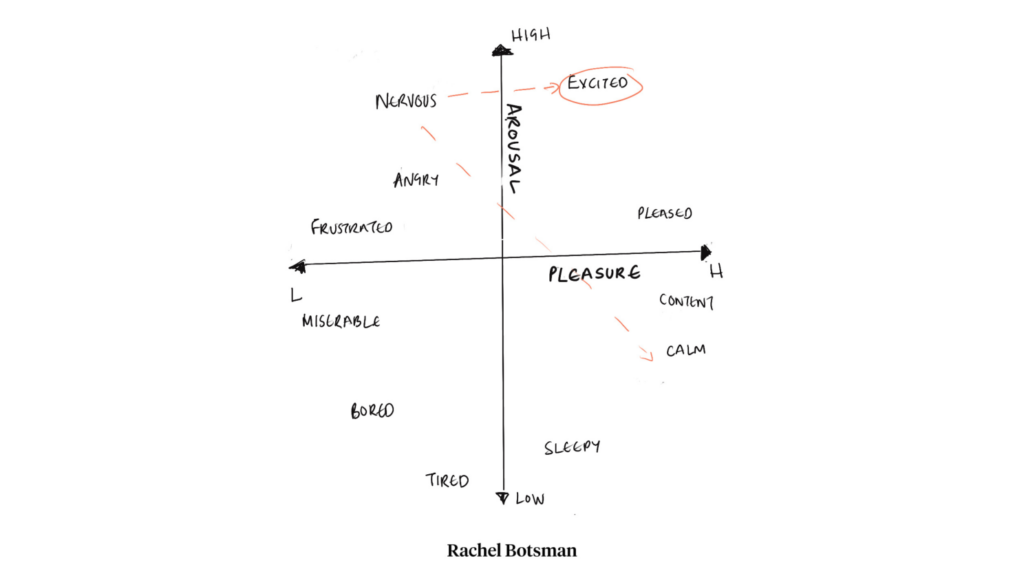Guest Post by Rachel Botsman | Rethinking Nerves

This is a guest post by WWSG thought leader, Rachel Botsman, originally posted here.
When did you last feel really nervous about something?
A strange thing happened to me last week – I got the most nervous I’ve been in a long time whilst giving a presentation. I know this doesn’t sound odd, given that a fear of public speaking is a very common phobia. But over the past decade, my career has involved giving hundreds of talks. I’ve learned how to control my adrenaline to the point that walking on the stage feels like entering a calm bubble.
But the setting was different this time – I was in a classroom as the student, not the teacher. It got me thinking about nerves. When and why do we get nervous?
Stepping into the unknown
As some readers know, I’ve returned to school for a year with the London School of Garden Design at Kew Gardens to study a lifelong interest in landscape design. In this presentation in front of my new classmates, I was taking a ‘trust leap’ as a total beginner, not the expert.
Nerves often arise in situations where there is one or more of the following:
- A lack of experience
- An evaluation (real or imagined)
- Status difference
- Sharing new ideas
- A new audience
Tick, tick, tick, tick!
I haven’t been a student for 22 years, and I haven’t drawn for two decades! My peers and the tutor know very little about my background or trust expertise. It’s stimulating but incredibly confronting. When it came to my turn to present my work, I got that sweaty, hot, heart-racing, dry throat sensation that I hadn’t felt in a long time.
When we stop leaping into the unknown
I realised something powerful in that moment; it was weirdly refreshing to feel nervous again. Like a courage spot inside of me that had been languishing had now been fired up.
Sometimes we don’t feel nervous because we’ve become highly competent, but there is also a danger that we’re also numb to the experience. We’ve stopped stepping from the comfortable and familiar into the unknown.
Quick exercise for you: when did you last feel nervous at work?
Perhaps it was one of the following situations:
- Meeting a new client or team
- Negotiating a pay rise
- Walking into a room full of people you don’t know
- Having to give a pitch, presentation, or talk
These different situations have one thing in common: they all require vulnerability.
Vulnerability, according to Brene Brown, is “uncertainty, risk, and emotional exposure.” It’s that unstable feeling we get when we’re engaged in something that forces us to let go or loosen control. It requires a lot of self-trust. So why, at times, do we enjoy this rush of the unknown and at other times feel nervous?
Fear of judgement and rejection
Evolutionary psychologists believe there are primordial roots as to why a fear of public speaking (known as ‘glossophobia’) is the most common phobia ahead of spiders, heights, and even death.
Living in tribes has long been an essential survival skill. In pre-historic times, rejection from the group could lead to death. When we stand in front of an audience, we’re ultimately vulnerable to judgement and rejection, much like our ancestors’ fears. Nerves rise when there is an underlying fear of a negative evaluation or judgement by others.
Nerves are a stress response that happen when we’re:
- Consumed by what others will think of us vs what we’re saying
- Trying to establish our credibility, image, or status in a new setting or group
- Feeling insecure about our experience and seeking approval

Trying to calm down is bad advice
I’ve been fortunate to give talks at TED, the World Economic Forum and the Lincoln Centre in New York City. I say this not to show off, but these are big imposing stages with many eyeballs looking at you! There are cameras, lights, and massive screens. I’ve learned to silence nervous chatter through various techniques. My favourite is always starting with an interactive question to the audience: it takes the attention away from you, the speaker, and gets people thinking instead of judging.
You may have been told to try to relax and calm down before giving a talk or presentation. It’s advice that needs rethinking. Alison Wood Brooks of Harvard Business School studies the effectiveness of doing just the opposite – getting excited.
Calmness is a positive state but it’s also low on arousal. Trying to go from a state of nerves to calm is like asking your brain to go from speeding along the motorway to driving through a quiet country village at 20 mph. It requires shifting your arousal (from high to low) and your valence (from negative to positive.) For most people, it requires far less effort to jump from one charged-up state to another – from negative feelings of nervousness to positive feelings of excitement. It’s a switching technique that is called “anxiety reappraisal” and it works!
Now, when I step in front of the class at Kew there is a different dynamic to lean into – the thrill of pure learning. So, here’s to the courage to rediscover the student, the beginner, inside all of us again and to enjoy the excitement of nerves.
Warmly,

